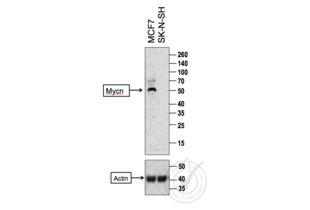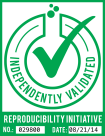MYCN anticorps (AA 401-464)
-
- Antigène Voir toutes MYCN Anticorps
- MYCN (N-Myc Proto-Oncogene Protein (MYCN))
-
Épitope
- AA 401-464
-
Reactivité
- Humain, Souris
-
Hôte
- Lapin
-
Clonalité
- Polyclonal
-
Conjugué
- Cet anticorp MYCN est non-conjugé
-
Application
- ELISA, Immunofluorescence (Cultured Cells) (IF (cc)), Immunofluorescence (Paraffin-embedded Sections) (IF (p)), Immunohistochemistry (Paraffin-embedded Sections) (IHC (p)), Immunohistochemistry (Frozen Sections) (IHC (fro))
- Homologie
- Rat,Cow,Pig
- Purification
- Purified by Protein A.
- Immunogène
- KLH conjugated synthetic peptide derived from human n-Myc
- Isotype
- IgG
-
-
- Indications d'application
-
ELISA 1:500-1000
IHC-P 1:200-400
IHC-F 1:100-500
IF(IHC-P) 1:50-200
IF(IHC-F) 1:50-200
IF(ICC) 1:50-200 - Restrictions
- For Research Use only
-
- by
- Alamo Laboratories Inc
- No.
- #029800
- Date
- 21.08.2014
- Antigène
- Numéro du lot
- 120917
- Application validée
- Western Blotting
- Contrôle positif
- MCF7 cells (variant MCF7/VP)00284-0/pdf)
- Contrôle négative
- SK-N-SH cells - RNA
- Conclusion
- A strong band was observed in the positive control sample at the correct molecular weight. An additional band was also observed in the positive sample at a higher molecular weight which may represent non-specific binding. No bands were observed in the negative control sample.
- Anticorps primaire
- Antigen: Mycn (MYCN)
- Catalog number: ABIN760676
- Lot number: 120917
- Antibody Dilution: 1:200
- Anticorps secondaire
- Antigen: Goat Anti-Rabbit IgG (H + L)-HRP Conjugate
- Lot number: L170-6515
- Antibody Dilution: 1:10,000
- Full Protocol
- 1. The cell extracts were heated at 95°C for 5 minutes in 1X SDS Sample Buffer containing 1% SDS and 1.25% β-mercaptoethanol.
- 2. 15 μl of heated culture-media were loaded and resolved on 8-16% SDS-polyacrylamide gel.
- 3. The Thermo Scientific - Spectra Multicolor Broad Range (Cat # 26634) were used as molecular mass markers.
- 4. Proteins were then transferred onto PVDF membrane by wet transfer and protein transfer was confirmed with Ponceau-S staining.
- 5. The PVDF membrane was incubated with 25 ml of blocking buffer [Tris Buffered Saline, pH 7.4 plus 0.1% TW20 (TBST)] containing 5% (W/V) BSA at room temperature for 1 hour.
- 6. The membrane was rinsed with TBST once.
- 7. The membrane was immersed with the protein side up in the primary antibody solution in TBST containing 5% (W/V) BSA and incubated for 13 hours at 4°C.
- 8. The membrane was rinsed in TBST thrice for 5 minutes each.
- 9. The membrane was incubated in the HRP-conjugated secondary antibody solution in TBST containing 5% (W/V) BSA and incubated for 1 hour at room temperature (~26°C) with gentle agitation.
- 10. The membrane was rinsed thrice TBST thrice for 5 minutes each.
- 11. The membrane was rinsed in TBS twice for 30 seconds each.
- 12. Signals were detected with ECL-2 Substrate. The blot was scanned for 45 minutes.
- 13. The membrane was rinsed three times TBST.
- 14. Incubated in Acidic Glycine Stripping Buffer at room temperature with gentle agitation for 3 times, 10 minutes each.
- 15. The membrane was washed in TBST 2 times for 10 minutes each.
- 16. Repeated Steps 5-12 with the loading control antibody (for Anti-actin) and its matching secondary antibody.
- Notes
- - No experimental challenges noted.
Validation #029800 (Western Blotting)![Testé avec succès 'Independent Validation' signe]()
![Testé avec succès 'Independent Validation' signe]() Validation ImagesProtocole
Validation ImagesProtocole -
- Format
- Liquid
- Concentration
- 1 μg/μL
- Buffer
- 0.01M TBS( pH 7.4) with 1 % BSA, 0.03 % Proclin300 and 50 % Glycerol.
- Agent conservateur
- ProClin
- Précaution d'utilisation
- This product contains ProClin: a POISONOUS AND HAZARDOUS SUBSTANCE, which should be handled by trained staff only.
- Stock
- -20 °C
- Stockage commentaire
- Store at -20°C for one year. Avoid repeated freeze/thaw cycles.
- Date de péremption
- 12 months
-
-
: "Serum-circulating miRNAs predict neuroblastoma progression in mouse model of high-risk metastatic disease." dans: Oncotarget, Vol. 7, Issue 14, pp. 18605-19, (2016) (PubMed).
-
: "Serum-circulating miRNAs predict neuroblastoma progression in mouse model of high-risk metastatic disease." dans: Oncotarget, Vol. 7, Issue 14, pp. 18605-19, (2016) (PubMed).
-
- Antigène
- MYCN (N-Myc Proto-Oncogene Protein (MYCN))
- Autre désignation
- N-Myc (MYCN Produits)
- Synonymes
- anticorps MODED, anticorps MYCNOT, anticorps N-myc, anticorps NMYC, anticorps ODED, anticorps bHLHe37, anticorps Nmyc, anticorps Nmyc-1, anticorps Nmyc1, anticorps c-nmyc, anticorps Nmuc1, anticorps fb57a02, anticorps nmyc1, anticorps wu:fb57a02, anticorps zgc:85706, anticorps XN-myc, anticorps XNmyc, anticorps mycn, anticorps mycn-a, anticorps mycn-b, anticorps mycna, anticorps xN-myc1, anticorps MYCN proto-oncogene, bHLH transcription factor, anticorps v-myc avian myelocytomatosis viral oncogene neuroblastoma derived homolog, anticorps v-myc avian myelocytomatosis viral related oncogene, neuroblastoma derived, anticorps olfactory receptor 8S1, anticorps MYCN proto-oncogene, bHLH transcription factor S homeolog, anticorps MYCN, anticorps Mycn, anticorps LOC515887, anticorps mycn, anticorps mycn.S
- Sujet
-
This gene is a member of the MYC family and encodes a protein with a basic helix-loop-helix (bHLH) domain. This protein is located in the nucleus and must dimerize with another bHLH protein in order to bind DNA. Amplification of this gene is associated with a variety of tumors, most notably neuroblastomas. [provided by RefSeq, Jul 2008].
Subcellular location: Nucleus
Synonyms: NMYC, ODED, MODED, N-myc, bHLHe37, N-myc proto-oncogene protein, Class E basic helix-loop-helix protein 37, MYCN
- ID gène
- 4613
- UniProt
- P04198
-


 (1 reference)
(1 reference) (1 validation)
(1 validation)



